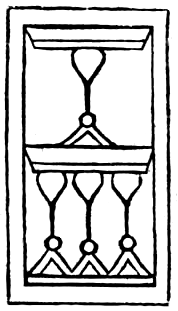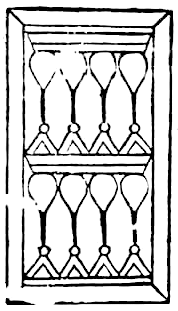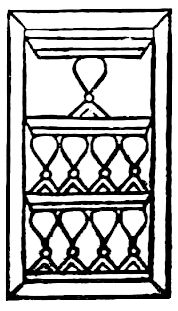Mamluk card fragment, c. 1300?
Even though the Topkapı deck is younger than the earliest European decks which appear in the 14th century, it is very similar to a fragment of a card dated to around 1300. This dating is presumably is done on art historical grounds on a very small fragment, and must be regarded as highly uncertain. Still, it strengthens the assumption that playing cards entered Europe by way of its islamic neighbours, and that the Topkapı deck is the closest we have come to the design of the prototype for all European playing cards.
The fragment consists of the top right corner of a card, possibly the four of cups. As the card seems to have a symmetrical design, and almost exactly half the width of the card survives, the top part of the card can be reconstructed with a fair degree of certianty just by joining it to its mirror image. It is more difficult to deduce what is missing in the lower part, or even how much that is missing.
As the card is split lengthwise along the center, it might once have been folded in half along its length. In that case, the horizontal crease mark might be the result of the card having been folded in half from top to bottom also. This would result in a card that is less elongated that both the Topkapı cards and many early European ones.
On the other hand, there might have been a second tier of cups, as in some very early European cards. This means that the card would not be the four of cups, but rather eight, nine or possibly seven. While this would give the card proportions more similar to the Topkapı cards, the glimpse of the area below the bar on which the two visible cups rest does not contain the faintest trace of such a design.
 |
 |
 |
Compare the 4, 8 and 9 of cups from an early European Moorish style
deck:
 |
 |
 |